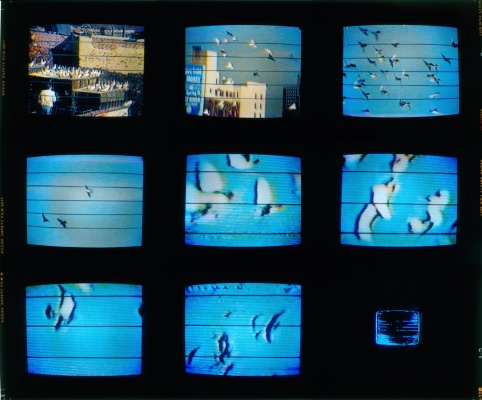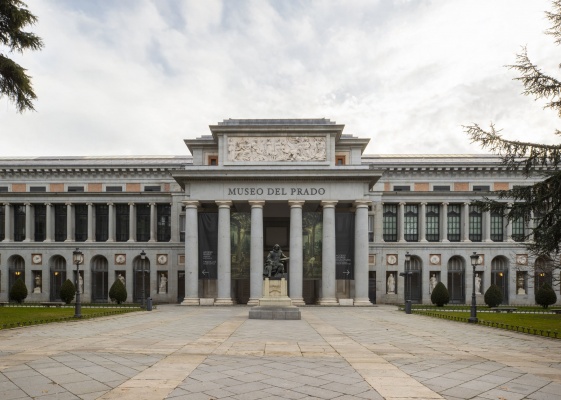Descripción de la Exposición
I wanted to send out an image of smoke into the atmosphere
(Ana Mendieta, 1981) [i]
This solo-exhibition shows, for the first time in Belgium, a wider selection of works by the Cuban-born artist Ana Mendieta (1948–1985). Forty-three years after she performed at the ICC (Internationaal Cultureel Centrum) on 24 April 1976, Antwerp welcomes her art again. Her sculptural filmworks and photographs position themselves effortlessly in today’s international canon of contemporary works and will be shown for the first time ever in an outdoor sculpture park, at the Middelheim Museum in Antwerp.
Earthbound opens up perspectives on how we relate as human beings to our surrounding environment. Through a direct bodily connection with nature, Mendieta’s works seek both a means of individual self-representation and a connection to universal ancestral power. In the context of the Middelheim Museum, where both the artist and the visitor are always subjected to the elements, Mendieta’s artistic ideas resonate. It’s absolutely clear that they not only raises fundamental questions about normative social systems, but that it also represents a shift in perspective on recent sculpture traditions, from a vision determined by figurative sculpture, to one connected with land art and performance.
Art as Refuge
Fleeing from Cuba to the US and displaced from her family as a young adolescent, Mendieta experienced an ongoing state of unrest. In her new environment she experienced being ‘other’, but marginality because of cultural or sexual differences can also become an active strategy and a liberating source. This is precisely how she developed her diverse, artistic oeuvre. [ii]
I am overwhelmed by the feeling of being cast out from the womb (Nature)…. My art is the way I reestablish the bonds that unite me to the Universe. It is a return to a maternal source.
(Ana Mendieta, 1983) [iii]
Art critics have been connecting Mendieta’s work with the idea of the great goddess or female figure. However, the use of the female silhouette originated from her interest in ancient and indigenous cultures. The search for maternal power and origin plays a central role in her early works, when her frequent travels to Mexico aroused her artistic inspiration. She recognized similarities between Mexican and Cuban culture in, for example, hybrid religious practices in which precolonial elements and Catholic rituals merged with one another. It was her interest in ancient civilizations that led her to Mexico, where the archaeological sites brought her into contact with an ancient, primitive culture. She was especially interested by their animistic world view and their direct connection with and respect for nature. In 1973, on one of these sites – Yagul in the Valley of Oaxaca – Mendieta created her first Silueta (Silhouette).
I have been carrying on a dialogue between the landscape and the female body (based on my own silhouette). (Ana Mendieta, 1981) [iv]
The artist lay down in an Aztec tomb and covered her body with white flowers, so that they seemed to grow out of her naked body. The flowers were those used for the Day of the Dead, the Mexican memorial festival. In this work, Mendieta experienced an intense connection with the earth and the origins of civilization. From that moment on she created a large body of work, which she called the Silueta Series, using her own body or its imprint in conjunction with natural materials such as clay, branches and gunpowder. She generally described her pieces as ‘Earth-Body’ works, interventions in the landscape that placed her body in a symbiotic relationship with its direct environment. Her works can be related to certain aspects of the land art tradition, where artists such as Richard Long create works in collaboration with nature in a non-invasive way [v].
Earthbound
During her own lifetime, during the 1970s and ‘80s, Mendieta was already concerned about the fragility of our ecosystem: in 1981 she talked about the ‘destructive effects of technological society on nature’ in a lecture at Alfred State University, New York. In her work she strove to create a new kind of relationship with the nature that produced us [vi].
Bruno Latour describes in his 2017 book Facing Gaia a radical strategy for realising a ‘new climatic regime’ as a solution to the current climatological crisis. He calls upon Gaia, inspired by the primal image of Mother Earth, who rejects modern humans because, through the disrespectful plunder of the lifeless earth, they brought us to this general state of crisis. Latour proposes that we should change our relationship with our environment but that this change can only be realized by what he calls the ‘Earthbound’. The Earthbound are occupied by the earth, in contrast to the Humans who occupy the earth disrespectfully. Crucial in this respect is recognizing that Gaia is active, just like the Earthbound, and that they both have agency. According to Latour, thinking beyond the boundaries of systems such as religion, politics and science is the only possibility for sustainable progress. We have to make new marks on the earth and to think beyond the imaginary realm of two-dimensional maps with highlighted borders. If anybody can help us develop our imagination and courage necessary for these tasks, it might be artists [vii].
This framework might offer an interesting perspective for exploring the work of Mendieta. By acknowledging that nature and its elements all have agency, she was able to think beyond the boundaries of religion, history and identity. She did not just simply use the environment, but ensured cross-integration via mutual respect. Her worldview is not anthropocentric, and the relationship of man to his environment is crucial. Just as the Eartbound relate to a system, a network of other actors, Mendieta’s work is an interaction between the land and the actions and traces of a woman. She addressed live relationships and the flux of all earthly elements, including the flesh of the human animal. In that respect her work is direct, sensitive and precise, but also uncompromising [viii].
The Four Elements
I believe in water, air, earth. They are all deities. (Ana Mendieta)[ix]
The selection of works included in Earthbound focuses on Mendieta’s fascination with the four elements: earth, water, air and fire. According to Mendieta, their agency is their purifying power of transformation, which enhances nature’s regenerative quality: the land engulfs, water flows, fire consumes and the wind blows. The four elements directed the artist’s approach in an extensive series of films and videos, with the result that of her 104 filmworks there are 38 that feature fire and 19 that feature water. In most of Mendieta’s works one can distinguish more than one element, which goes to underline only the mutual coherence and symbiosis of the whole. This explains why her multilayered work cannot be easily classified into categories and why there always lingers a mysterious aspect beyond our understanding. For this reason, we have not structured the exhibition by simply arranging the works according to their use of a particular element.
For Mendieta, the four elements and the relationships between them have a spiritual power and universality that enable us all to connect with them. She was particularly fascinated by the rituals and iconography of Santería, the Afro-Cuban hybrid religion, and incorporated elements in her work. For example, in the performance Blood + Feathers, which took place on the sandy bank of a creek, she poured animal blood over her body and then plunged herself into a pile of white turkey feathers; in a similar vein was her 1976 performance at the ICC. Like these performance pieces, her filmworks and photographs in the current exhibition are clearly a personal response to both individual and collective memories [x].
Earthbound represents the diversity of Mendieta’s oeuvre and her inexhaustible artistic energy. In the film Burial Pyramid, 1974 (film no. 27), the artist is buried under a mound of stones – perhaps symbolizing the earth and its immemoriality – which, with the effort of her breathing, gradually roll off her, allowing her to appear uncovered and resuscitated by the end of the 3-minute piece. In Creek, 1974 (film no. 22), Mendieta achieves a fragile balance between vulnerability and security, as if her naked body merged with the shallow water and placed diagonally across the film’s frame holds these two opposites in a perfect equilibrium. As present as the body is in Creek, it is equally absent in Ochún, 1981 (film no. 104).
Ochún – the final piece in a “trilogy about displacement, return and reconciliation” – is the last moving image work that Mendieta made. The body is represented by an open Silueta shape, so that the water can flow through it, while not erasing the body’s connection with the water. Made in the sea at Key Biscayne, Florida, and oriented towards Cuba, the water that is now flowing through the Silueta and bringing peace is the same stretch of water that first separated the artist from her homeland [xi]. In the Santería religion, Ochún is the goddess of water and has the power to bring unity. Ochún is an apt metaphor for Mendiata’s separation and return to Cuba in later life during a period of intense artistic activity, the water also alluding to distance and the passing of time. This work is a pre-eminent example of Mendieta transforming her personal suffering into a powerful strategy in order to tackle the incompatible forces of her destiny [xii].
The exhibition Ana Mendieta. Earthbound is a collaboration with the Estate of Ana Mendieta Collection & Galerie Lelong & Co.
IN CONJUNCTION TO THE EXHIBITION
Artist talk
Saturday 25 May, at 1 PM
With Raquel Cecilia Mendieta, Ricardo Brey, Ria Pacquée, Johan Pas and Sara Weyns
Moderated by Pieter Boons
Opening of the exhibition
Saturday 25 May, at 2.30 PM
Welcome by Sara Weyns, Director of the Middelheim Museum
Official opening of the exhibition by Nabilla Ait Daoud, Vice-Mayor and Alderman for Culture
Introduction to the exhibition by Pieter Boons, Curator of the Middelheim Museum

Exposición. 08 may de 2025 - 14 sep de 2025 / MNAC - Museu Nacional d'Art de Catalunya / Barcelona, España

Formación. 30 oct de 2025 - 11 jun de 2026 / Museo Nacional del Prado / Madrid, España